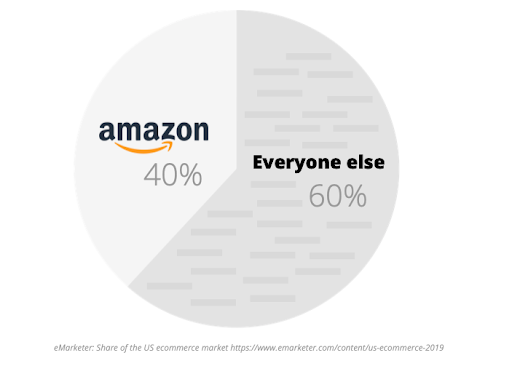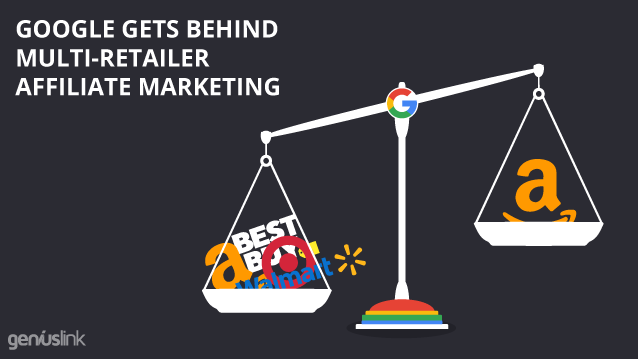Google Gets Behind Multi-Retailer Affiliate Marketing
-
Jesse is a Native Montanan and the co-founder and CEO of Geniuslink - or, as he likes to say, head cheerleader. Before Jesse co-founded Geniuslink, he was a whitewater rafting guide, worked at a sushi restaurant, a skate/snowboard shop, was a professional student, and then became the first Global Manager at Apple for the iTunes Affiliate Program.
- October 25, 2023
So what does Google have to do with affiliate marketing? In its simplest form, getting traffic and monetizing traffic are two sides of the same “affiliate marketing” coin, and one of the most common ways to get traffic is via Google’s search algorithms (remember Google also owns YouTube…).
And if you follow along, Google will often let you know what they need from you to be able to get you traffic that you can go on to monetize via affiliate links. I’m guessing 99% of you reading this, know this.
But, in case you haven’t been following Google closely in the last couple of weeks, they shared an opinion on how some things should be done when recommending products (and monetizing those product recommendations).
On December 1st, 2021 they shared the “December 2021 Product Review Update,” which appears to be part two to a similar update that came out in April. In this update they gave an overview of why they are making the change then called out two specific things they were going to be looking for going forward:
“Users have told us that they trust reviews with evidence of products actually being tested, and prefer to have more options to purchase the product. Provide evidence such as visuals, audio, or other links of your own experience with the product, to support your expertise and reinforce the authenticity of your review. Include links to multiple sellers to give the reader the option to purchase from their merchant of choice.”
It’s that last sentence that we are going to focus on today.
What is Multi-Retailer Affiliate Marketing?
Multi-Retailer affiliate marketing is the practice of recommending a single product (or service) across two or more different retailers or vendors. Only including Amazon affiliate links in your blogs and videos is NOT Multi-Retailer affiliate marketing. Recommending a certain camera with links to Amazon, B&H Photo Video, and Adorama is Multi-Retailer affiliate marketing.
Why Should We Care about Multi-Retailer Affiliate Marketing?
While taking the Multi-Retailer approach to affiliate marketing is a bit more challenging than just slapping Amazon affiliate links everywhere there are some really compelling reasons to start using the approach. Some of these include:
1/ Supply Chain and Out of Stock issues
It’s not new news that our favorite stores just don’t have all of our favorite things in stock all the time like they used to. Blame it on COVID, or big ships getting stuck in small channels, a shortage of workers, or about 100 other things but the gist is that sending someone to a store that doesn’t have the product you are recommending in stock is a dead-end buying experience and your conversion rate is likely to go to zero.
You can hedge your bet and by including multiple different retailers that sell the same product you are more likely not to see your conversion rate drop significantly when one store no longer carries the product. Learn more here: Out of Stock: The Holiday 2021 Playbook Every Affiliate Marketer Needs to Read.
2/ Comparison / Bargain Shopping
While there is some shopper loyalty still out there (Amazon Prime was a brilliant idea), finding the cheapest price is often still the M.O. of many shoppers, especially for higher-priced items. Turns out 78% of shoppers say they like to do comparison shopping and 81% of consumers conduct online research before making a purchase online.
By giving your shoppers links to multiple retailers for a specific product they can feel fulfilled in their research as well as check prices to find the best deal using YOUR affiliate links instead of inadvertently encouraging them to jump over to Google Shopping where they’ll inevitably click on other affiliate links. With last-click attribution still the prominent affiliate tracking methodology it means you lose out on the chance of earning a commission when your shopper clicks and buys from someone else’s links.
3/ Reduce Your Dependency on Amazon
We absolutely love Amazon’s affiliate program and strongly encourage it as the first affiliate program new creators use when starting to dive into the world of affiliate marketing.
But we also think that being completely reliant on Amazon’s affiliate program for all of your affiliate revenue can be problematic as you grow and thus recommend creators branch out to start using additional affiliate programs before they get burnt by being overly reliant on a single program.
For example, Amazon’s continued trend of reducing affiliate commission rates over the years (more details on the 3X decrease in the average commission rate over the last ten years), inexplicable drops in commissions, and challenging and authoritarian enforcement of their rules have pushed a growing number of affiliate marketers to start to diversify their affiliate revenue across multiple affiliate programs.

4/ Capturing the other 60% of the market
Amazon is huge, especially here in the US. Emarketer has them pegged at 40.4% of the US ecommerce market share, with Walmart next at 7%. BUT while 40% is huge that still means that 60% of ecommerce happens outside of Amazon.
That’s the equivalent of 3 out of every 5 dollars spent online happening elsewhere. Seems like a pretty huge piece of the pie to be missing out on, right? A Multi-Retailer approach to affiliate marketing helps you capture the whole market!

5/ Industry Best Practice
What do CNET, WireCutter, Digital Trends, Tom’s Guide all have in common besides being some of the biggest names in product review and making a ton of money from affiliate marketing?
They all have adopted a Multi-Retailer approach to affiliate marketing and rarely don’t include other retailers besides Amazon when making a product recommendation.

6/ Proven to Boost Commissions and Conversions
When we first started getting serious about Multi-Retailer we did a bunch of testing. We worked with nearly a dozen clients, built over a hundred A/B testing links, and ran tens of thousands of clicks through both the control (direct to Amazon) and test (Multi-Retailer Choice Pages) to get our results. In the end, we found that both the conversion rate and the total commissions more than doubled with our Multi-Retailer links compared to our direct to Amazon links! All the details can be found here.
And now, one more reason to adopt a Multi-Retailer approach to affiliate marketing.
7/ Google is recommending the practice
Inside of Google’s guidelines for “High Quality Review Content” , they state:
"Consider including links to multiple sellers to give the reader the option to purchase from their merchant of choice."
Seems like a pretty compelling list to me!
How do you actually adopt Multi-Retailer affiliate marketing?
Once you are ready to dive in there are numerous ways to start adopting the strategy.
Crawl
It can be as simple and straightforward as manually including an additional link when you write your review or video description on YouTube.
Walk
Taking this up a notch, there are also some manual tools that can help for WordPress / WooCommerce based sites. These would include tools like Product Retailers by SkyVerge or Modal Guten Block. Note that these tools require a fair amount of work on your side to identify the other retailers selling the same product, ensure they are converted into trackable affiliate links, and then these tools will help you add the links to your site and manage the visual aspects of displaying these additional retailers.
Run
Geniuslink has been focused on providing tools for a Multi-Retailer solution to our clients since 2016 and has been constantly iterating on the approach since then.
It turns out our patented product matching algorithms that are highly accurate matching inside the Amazon, Microsoft, and iTunes/Apple Services ecosystem are also really good at matching products between retailers. You can see this in action when you check out our “Suggestions” feature in the Geniuslink dashboard.
Geniuslink can help you quickly adopt a high-accuracy Multi-Retailer approach in three different ways:
Choice Pages
Choice Pages are mobile optimized and high converting landing pages that allow you to easily promote a single product across multiple vendors and are highly automated. If you share an Amazon.com product link with us we can take care of the rest of the build-out for you. You can then customize the image, title, call to action, theme, retailers included, as well as order. You can also add your logo to the page.
Choice Pages have a huge success for creators recommending products on social media (example A, example B, example C (see bottom of the page), example D-L) but we’ve also seen success from their usage within websites as well (example M).
Product Matching API (Private Beta)
For those building sites and apps and looking to fully integrate a Multi-Retailer approach we have an API available that provides JSON results of product matches.
Contact us if you’d be interested in exploring this option and joining our growing list of private beta users. An example of this API at work behind the scenes can be found on Kit – Jeven Dovey’s 2021 YouTube Filmmaking Gear List.
Multi-Retailer Embeds (2022 Launch)
In the coming year, we’ll be providing our clients with an easy-to-implement approach that mimics the same automated and highly accurate approach we’ve rolled out for Kit. Again, contact us if you’d be interested in being notified when this new feature rolls out.
Will Using Multi-Retailer Definitely Help My Google Rankings?
It’s still likely too early to tell definitively. Google has over 200 factors that go into ranking and the use of additional retailer buttons is likely a minor contributor.
However, we are hearing thought leaders in the space mention their adoption:
“I do intend to use this [Multi-Retailer] micro factor as a way to pull ahead of the competition.”
Gael Breton from Authority Hacker
While it might not be the silver bullet to get you on page one, the recommendation to use a Multi-Retailer approach to affiliate marketing seems to now be cemented among the best practices affiliate marketers are using to succeed. Bumping up in ranking might just be the icing on the cake from adopting this methodology.
Author
-
Jesse is a Native Montanan and the co-founder and CEO of Geniuslink - or, as he likes to say, head cheerleader. Before Jesse co-founded Geniuslink, he was a whitewater rafting guide, worked at a sushi restaurant, a skate/snowboard shop, was a professional student, and then became the first Global Manager at Apple for the iTunes Affiliate Program.
Author
-
Jesse is a Native Montanan and the co-founder and CEO of Geniuslink - or, as he likes to say, head cheerleader. Before Jesse co-founded Geniuslink, he was a whitewater rafting guide, worked at a sushi restaurant, a skate/snowboard shop, was a professional student, and then became the first Global Manager at Apple for the iTunes Affiliate Program.
More revenue from every link you share
Geniuslink makes localizing, tracking, and managing smart links dead simple, so you can earn more without added work.

